At least 34 people have died, more than 500 were injured, and over 120 are missing after a 6.4 magnitude earthquake struck Taiwan on Feb. 6. Many of the missing and injured were from one building, the 17-story Wei-guan Golden Dragon building in Tainan, south Taiwan.
The building, built in 1994, withstood a 1999 earlier earthquake, but was the only high-rise in Tainan to collapse in Saturday’s quake. The government is now investigating to see whether shoddy construction contributed to the collapse.
Photos of the collapsed building show cans marked “Alesco,” a Japanese brand of paint, lined up between the collapsed concrete walls (the blue and white cans in the photo above). News reports said that cooking oil cans were used as construction materials as well. Some residents of the building had their original applications for mortgages turned down because banks refused to make loans on it, knowing it was shoddily constructed, Reuters reports. But residents told Reuters they were not told by the banks about the construction worries.
Cooking oil cans were often used before the 1999 quake inside pillars to make them look bigger, an architect told local news agency CNA, but not for structural support. The construction companies that built the building are now out of business.




